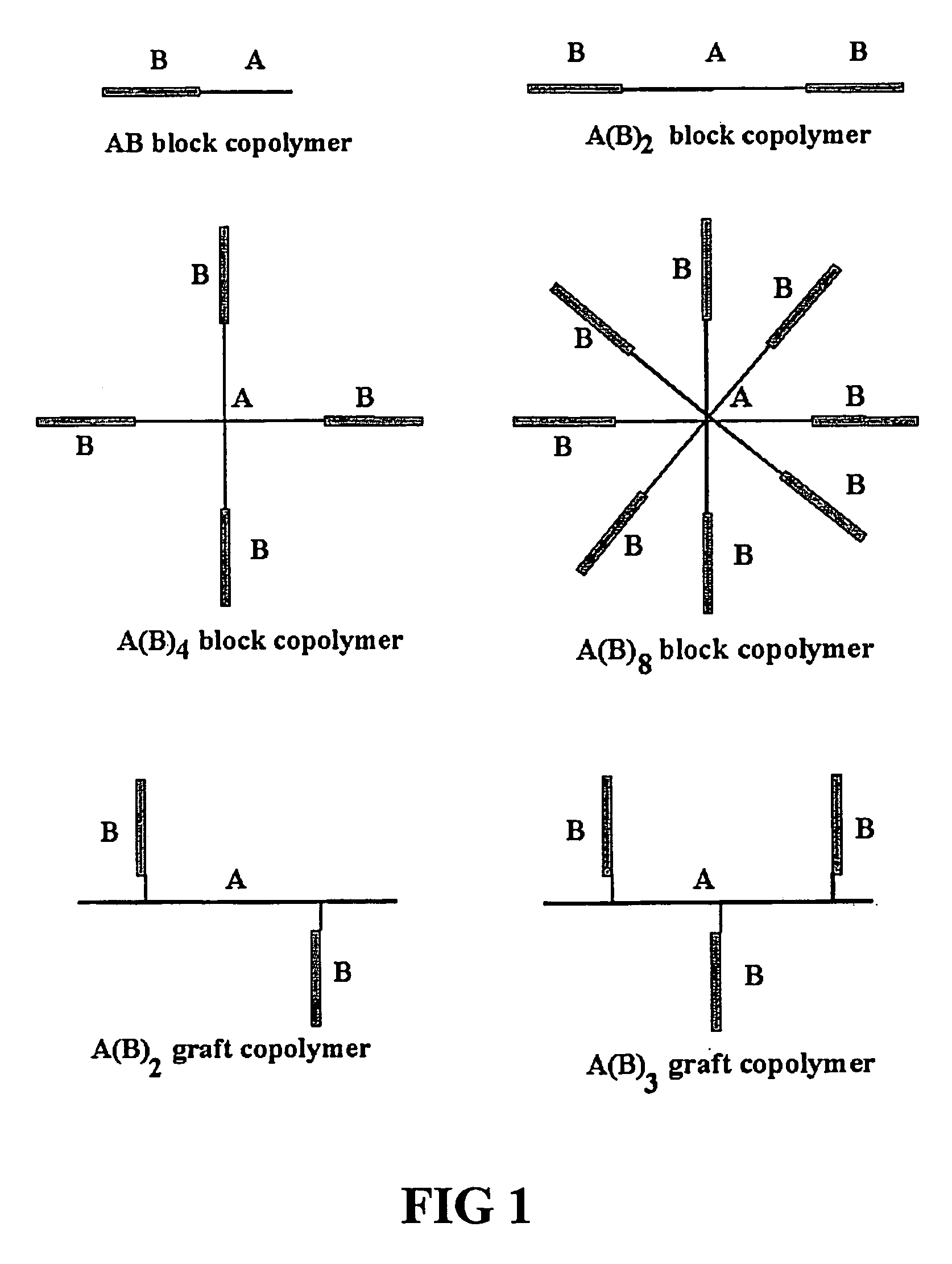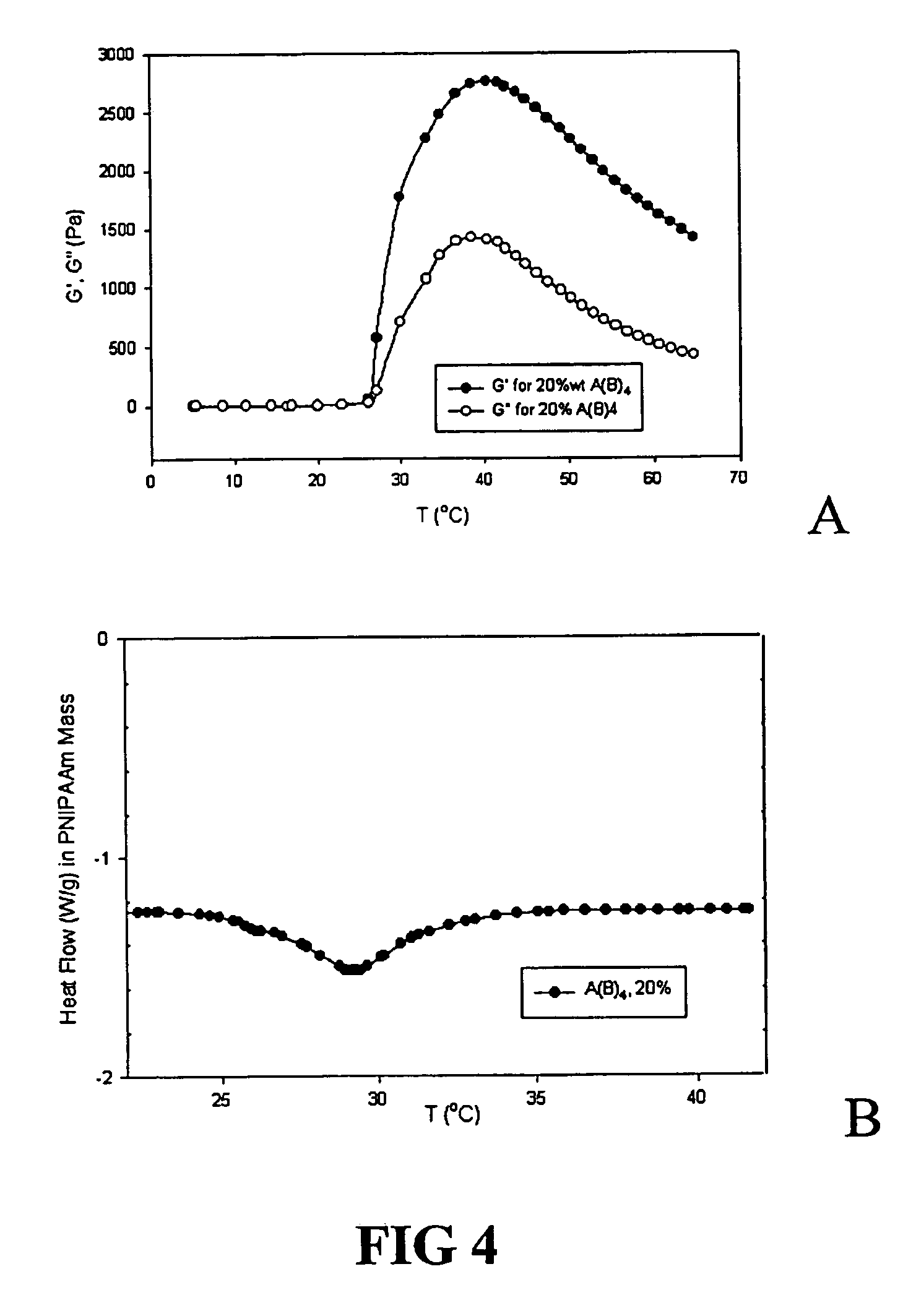Environment responsive gelling copolymer
a copolymer and environmental responsive technology, applied in the field of polymers, can solve the problems of in situ gelation application, none of the compositions designed and synthesized with solvent-induced gelation in mind,
- Summary
- Abstract
- Description
- Claims
- Application Information
AI Technical Summary
Benefits of technology
Problems solved by technology
Method used
Image
Examples
example 1
Two-Armed Block Copolymer PNIPAAm-PEG-PNIPAAm
[0083]Linear polyethylene glycol (MW 5077) with terminal hydroxyl groups at both ends of the chain, HO(CH2CH2O)113H, was purchased from Shearwater Polymer (product name Sunbright DKH-50H, Lot. 68559) and used without further treatment. This reagent is herein referred to as the two-armed PEG.
[0084]The two-armed PEG (1.0 g) was mixed with 1.35 g of purified NIPAAm, dissolved in water, then mixed with 2.0 ml of a 0.4 M Ce4+ solution, and 0.8 ml of 1N NaOH solution. The total mixture was 15 ml in volume. The reagents were cold mixed at 5° C. and sonicated to eliminate dissolved gas. The reaction was then allowed to proceed at 30° C. for 24 hours. At the end of 24 hours, the mixture was diluted to 100 ml by adding cold distilled water and placed in a 5° C. refrigerator to quench the reaction. The entire reaction was carried out under a helium blanket. The reaction vial was made of polypropylene instead of glass to avoid Ce4+ / OH-glass side reac...
example 2
Four Armed Block Copolymer PEG-(PNIPAAm)4
[0087]Four-arm branched polyethylene glycol (MW 10486) with one terminal hydroxyl group at each branch was purchased from Shearwater Polymer (product name Sunbright PTE-10000, Lot. 76606) and used without further treatment. This reagent is herein referred to as the 4-armed PEG.
[0088]The four-armed PEG (1.0 g) was mixed with 1.35 g of purified NIPAAm, dissolved in water, then mixed with 2.0 ml of a 0.4 M Ce4+ solution, and 0.8 ml of 1N NaOH solution. The total mixture was 15 mL in volume. The reagents were cold mixed at 5° C. and sonicated to eliminate dissolved gas. The reaction was then allowed to proceed at 30° C. for 24 hours. At the end of 24 hours, the mixture was diluted to 100 ml by adding cold distilled water and placed in a 5° C. refrigerator to quench the reaction. The entire reaction was carried out under a helium blanket. The reaction vial was made of polypropylene instead of glass to avoid Ce4+ / OH-glass side reaction, which coul...
example 3
Eight Armed Block Copolymer PEG-(PNIPAAm)8
[0091]Eight-arm branched polyethylene glycol (MW 19770) with a terminal hydroxyl group at each branch was purchased from Shearwater Polymer (product name Sunbright HGEO-20000, Lot. 7D543) and used without further treatment. This reagent is herein referred to as the 8-armed PEG.
[0092]The eight-armed PEG (1.0 g) was mixed with 1.35 g of purified NIPAAm, dissolved in water, then mixed with 2.0 ml of a 0.4 M Ce4+ solution, and 0.8 ml of 1N NaOH solution. The total mixture was 15 mL in volume. The reagents were cold mixed at 5° C. and sonicated to eliminate dissolved gas. The reaction was then allowed to proceed at 30° C. for 24 hours. At the end of 24 hours, the mixture was diluted to 100 ml by adding cold distilled water and placed in a 5° C. refrigerator to quench the reaction. The entire reaction was carried out under a Helium blanket. The reaction vial was made of polypropylene instead of glass to avoid Ce4+ / OH-glass side reaction, which ca...
PUM
| Property | Measurement | Unit |
|---|---|---|
| mass ratios | aaaaa | aaaaa |
| frequency | aaaaa | aaaaa |
| LCST | aaaaa | aaaaa |
Abstract
Description
Claims
Application Information
 Login to View More
Login to View More - R&D
- Intellectual Property
- Life Sciences
- Materials
- Tech Scout
- Unparalleled Data Quality
- Higher Quality Content
- 60% Fewer Hallucinations
Browse by: Latest US Patents, China's latest patents, Technical Efficacy Thesaurus, Application Domain, Technology Topic, Popular Technical Reports.
© 2025 PatSnap. All rights reserved.Legal|Privacy policy|Modern Slavery Act Transparency Statement|Sitemap|About US| Contact US: help@patsnap.com



